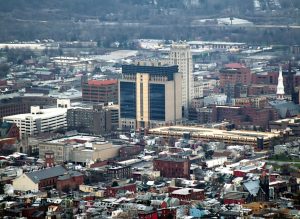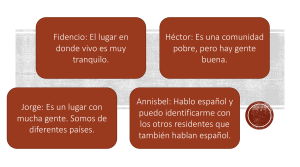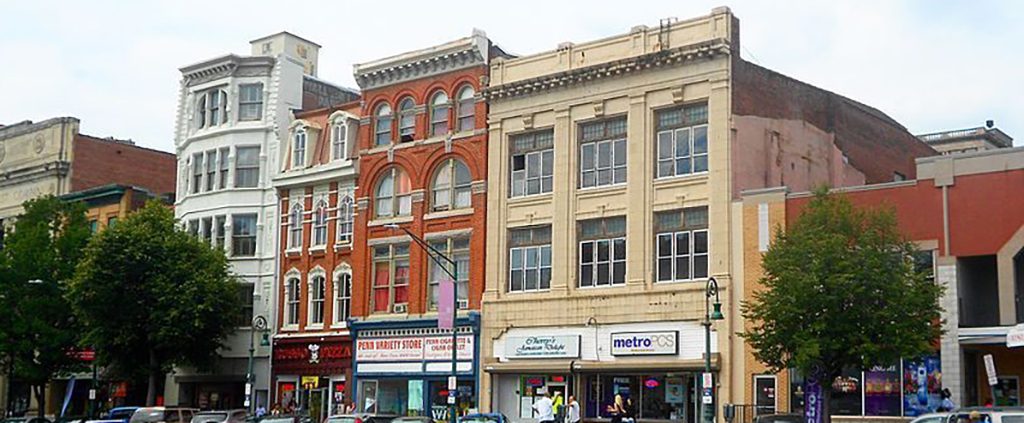¿Cómo es Reading, Pensilvania?

- Por dos minutos, escribe palabras en español y en inglés que tú asocias con Reading, Pensilvania.
- Compara tus ideas con tus compañeros de clase.
Voces de la comunidad
Aquí tenemos las opiniones de dos personas que viven en Reading. ¿Qué dicen ellos de su comunidad? ¿Sus experiencias son diferentes de tus ideas de Reading o son iguales? Compara tus ideas con las opiniones de Josephina y Anthony.
Entender y usar la materia: Comparaciones—Reading y mi lugar
First, gather some data. Sit with a classmate. On DataUsa’s website, look up information about Reading and either your town or city or the one nearest to your home that is on that website. If you’re from Reading, choose another town or city, maybe one you’ve lived in before or visited or would like to work in one day. For the two cities/towns, go to the diversity section of DataUsa’s site and compare these elements. Choose the “place” option for the cities and towns you are researching on DataUsa’s site. If you see a message that data is not available, go back to the top of the web page and search again using the “PUMA” (Public Use Microdata Area) function.
- ¿De qué países son la mayoría de las personas que no son nativas?
- Porcentaje de personas que son ciudadanos de los Estados Unidos
- Porcentaje de personas latinas, blancas, negras, multirraciales, etc.
- Aparte del inglés, ¿qué lenguas se hablan con más frecuencia?
Now, with a classmate, write sentences that compare Reading and your neighborhoods, towns, or cities (or the places on DataUsa that were closest to your homes). Here are some sample sentences to get you started; there are many different kinds of sentences that you can write.
- En Norristown, Pensilvania, y en Reading hay mucha gente de México. Pero en Norristown hay bastante gente de Corea también.
- El porcentaje de ciudadanos estadounidenses en Norristown y Reading es más o menos igual.
- El grupo étnico más grande de Reading son los latinos. En Norristown el grupo étnico más grande son los afroamericanos.
- Como en Norristown, en Reading se hablan inglés y español frecuentemente.
- En pocas palabras, Reading y Norristown son dos ciudades diversas.
Expressing What People Say
To express what people say, we use the verb decir in Spanish. It’s an irregular verb, so before you begin to work with it, watch the video: How to Conjugate Decir in the Present Tense to see how it’s conjugated.
¿Qué dicen?

Look at the photos above and in the quotations red boxes. Ask your partner who says each of them and answer by creating sentences that follow the model:
Modelo:
Estudiante 1: ¿Quién dice que el lugar donde vive es silencioso?
Estudiante 2: Josephina dice que el lugar donde vive es silencioso.
-
- Habla español con los otros residentes.
- Hay gente buena.
- Hay un mundo de gente diferente en Reading.
- El lugar donde vive es tranquilo.
- Es un lugar con mucha gente.
- Es una comunidad pobre.
Y tú ¿qué dices?
Now it’s time for you and your partner to find out what each other says about where you’re from and about Reading. Follow the model, but feel free to express your own thoughts and to be creative.
Modelos:
Estudiante 1: ¿De dónde eres?
Estudiante 2: Soy de Indianápolis.
Estudiante 1: ¿Qué dices de Indianápolis?
Estudiante 2: Digo que es interesante y grande.
Estudiante 1: ¿Y qué dices de Reading?
Estudiante 2: Digo que es más pequeña que Indianápolis.
Presentación: Una empresa latina de mi comunidad
Prepare a digital or paper poster and presentation about a Latino-owned business from your home state or where you go to college. You will include very few words here, so be sure they’re all in Spanish and correct. The only exception to the no-Spanish rule is when the name of the company or entrepreneur contains English. Include everything from this checklist.
- the name of the company or invention
- what kind of business it is (es un restaurante, es un banco, etc.), what sector of the economy it’s in (está en el sector de moda, está en el sector de tecnología, etc.), or what it produces (produce chocolate, produce computadoras, etc.)
- the name of the entrepreneur(s), if you can find it
- where and when he/she was born (large numbers are in the vocabulary list), if you can find that information.
- images or graphics to highlight the important information. Use public domain images and attribute them. Try
Creative Commons Search; it contains links to Wikimedia Commons, Pixabay, and other collections.
After completing this theme, I can …
- in Spanish, compare the city of Reading with another city or town (my home town or a place I’d like to live/work).
- in Spanish, share demographic information about diversity in Reading and another city or town (my home town or a place I’d like to live/work).
- in Spanish, report what others say in simple sentences.
- in Spanish, name and describe a Latino-owned business located either in my home state or in/near the city where I attend college.

